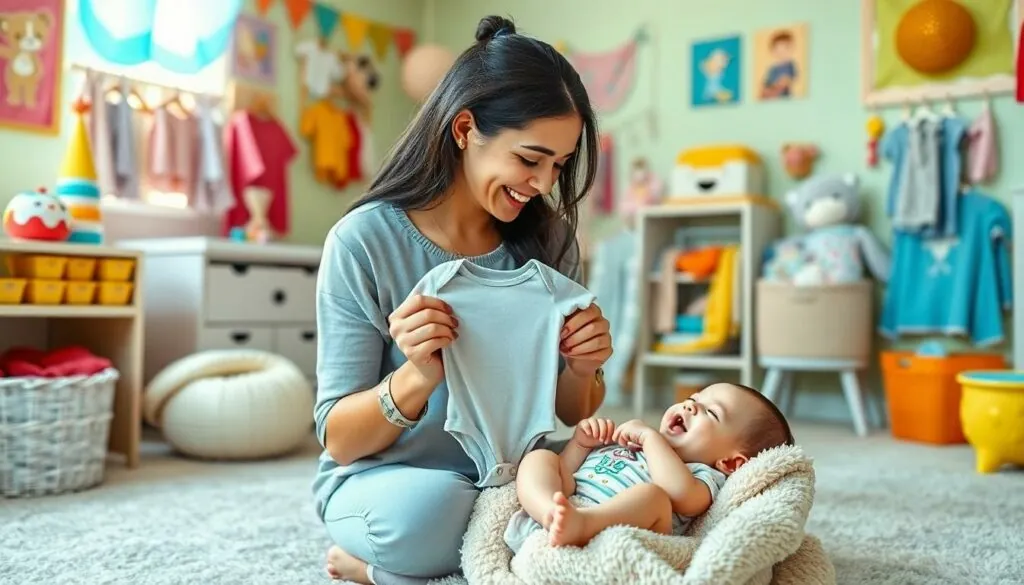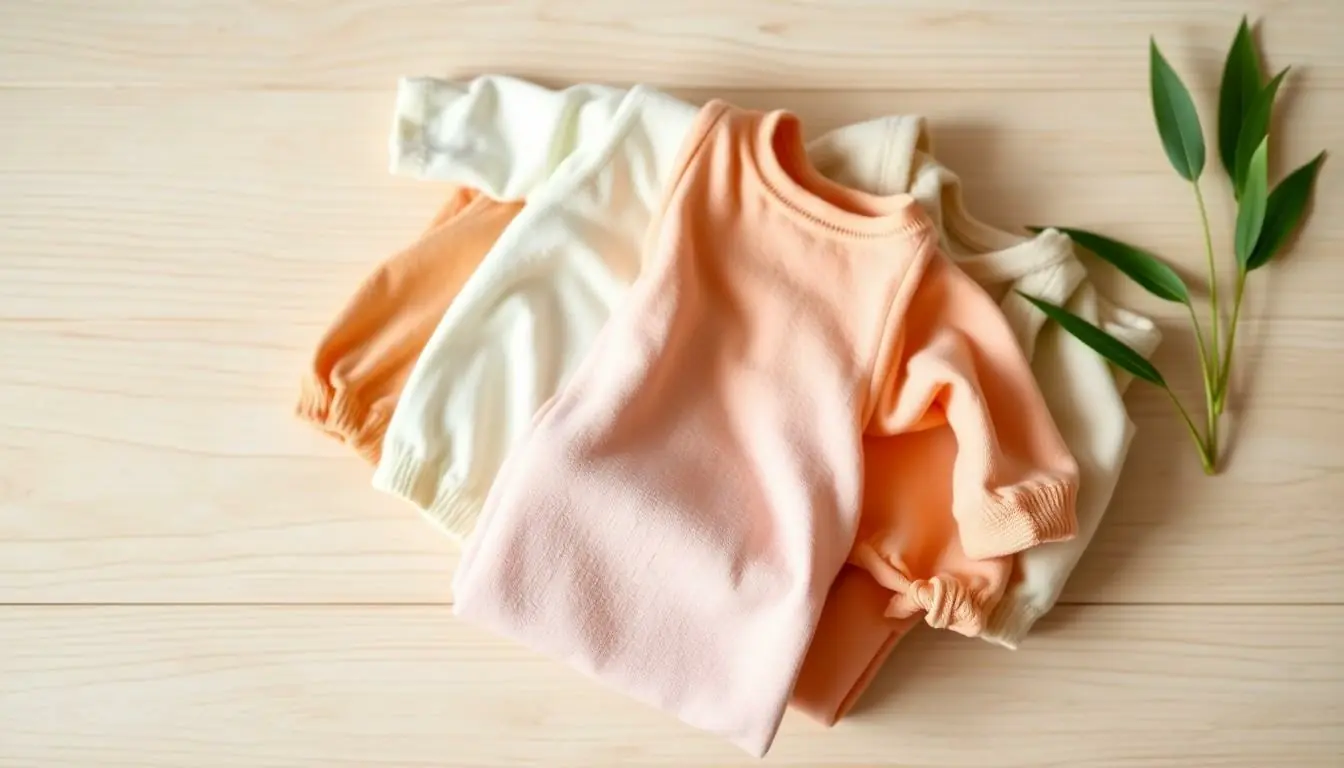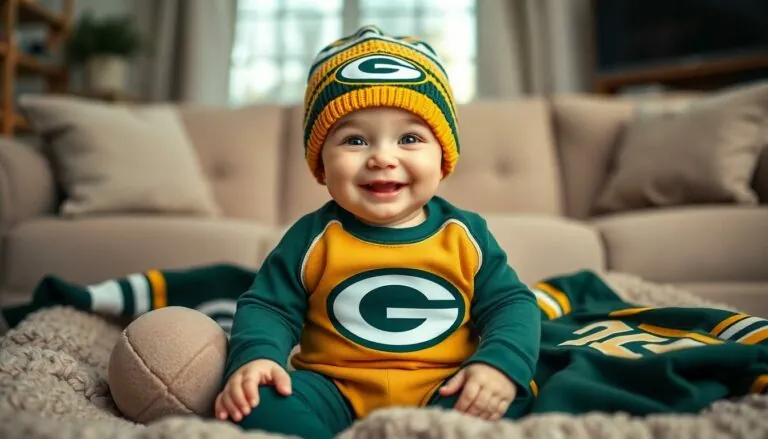Table of Contents
ToggleDressing a tiny human shouldn’t feel like solving a quantum physics equation! From onesies that snap in mysterious ways to zippers that seem to have a mind of their own baby clothes can turn any confident parent into a puzzled fashion coordinator.
Today’s baby gear market offers an overwhelming array of options from practical everyday essentials to Instagram-worthy designer outfits. Parents need to navigate through size charts growth spurts and seasonal changes while ensuring their little one stays comfortable and stylish. But don’t worry – with the right knowledge choosing baby clothes doesn’t have to break the bank or cause decision paralysis.
Baby clothes shopping has evolved beyond just picking cute patterns. Modern parents now consider factors like organic materials adaptive designs and multi-functional pieces that grow with their child. Let’s explore how to build a practical yet adorable wardrobe that’ll keep both baby and budget happy.
Essential Baby Clothes for the First Year
A well-planned baby wardrobe combines practicality with comfort to accommodate rapid growth during the first year. Parents maximize their investment by selecting versatile pieces that adapt to different stages of development.
Newborn Wardrobe Basics
Newborns require 8-10 bodysuits or onesies for daily wear changes. Snap-closure sleepers provide easy access for diaper changes while keeping babies cozy during sleep sessions. Essential clothing items include:
- 6 zip-up footed sleepers for nighttime comfort
- 4 stretchy side-snap shirts for umbilical cord care
- 6 pairs of no-scratch mittens to protect facial skin
- 8 soft cotton socks that stay in place
- 3 soft hats for temperature regulation
- 4 swaddle blankets with secure fasteners
| Clothing Type | Quantity | Replacement Frequency |
|---|---|---|
| Bodysuits | 8-10 | Every 3 months |
| Sleepers | 6-8 | Every 2-3 months |
| Socks | 8 pairs | Every 2 months |
Seasonal Considerations
Babies born in summer need lightweight cotton layers to prevent overheating. Winter babies require additional thermal protection through layered clothing. Key seasonal items include:
Summer Essentials:
- 4 lightweight cotton rompers
- 3 breathable sleep gowns
- 2 sun hats with UPF protection
- 4 muslin blankets for swaddling
- 3 fleece outerwear pieces
- 4 long-sleeve bodysuits
- 2 warm sleep sacks
- 3 knit caps for outdoor protection
| Season | Primary Fabric | Layer Count |
|---|---|---|
| Summer | Cotton muslin | 1-2 layers |
| Winter | Cotton fleece | 2-3 layers |
Choosing the Right Fabrics and Materials
Baby clothing materials impact comfort, safety, and skin health. The selection of appropriate fabrics serves as a crucial factor in ensuring optimal temperature regulation and preventing skin irritation.
Natural vs Synthetic Fibers
Natural fibers offer superior breathability and temperature regulation for baby clothing. Cotton leads as the primary choice, providing 100% hypoallergenic properties ideal for sensitive skin. Organic cotton eliminates exposure to harmful pesticides and chemicals during production. Bamboo fabric delivers natural antimicrobial properties while maintaining softness against delicate skin. Merino wool creates excellent temperature control, keeping babies warm in winter and cool in summer.
Synthetic materials like polyester or nylon present durability benefits but limit breathability. These fabrics trap heat and moisture, potentially causing discomfort or skin rashes. A blend of 80% natural to 20% synthetic fibers balances comfort with practicality for specific clothing items like outerwear or water-resistant gear.
Safety and Comfort Features
Safety elements in baby clothing include flat seams, tagless labels, and snap-free designs. Reinforced stitching prevents loose threads from causing injury. Wide neck openings accommodate babies’ larger heads while ensuring easy dressing. Elastic waistbands provide secure fits without restricting movement.
Comfort features incorporate adjustable elements to extend wear time through growth phases. Envelope-style necklines allow easy removal during diaper incidents. Zip guards protect delicate skin from zipper friction. Fold-over mittens prevent scratching while maintaining warmth. Temperature-regulating fabrics maintain optimal body heat in varying conditions.
Smart Storage Solutions for Baby Clothes
Effective storage systems keep baby clothes organized through multiple size changes. Parents benefit from systematic organization methods that maximize space while maintaining easy access to current sizes.
Organization Tips
- Install closet dividers labeled with clothing sizes from 0-24 months
- Group outfits by type: sleepwear, everyday wear, special occasions
- Sort clothes in clear storage bins with size labels on multiple sides
- Place current size items at eye level in drawers or closets
- Store seasonal items in vacuum-sealed bags under the bed or high shelves
- Use drawer organizers to separate small items like socks, mittens, hats
- Create a designated space for clothes that need washing or mending
- Implement a rotation system for current, outgrown, next-size clothing
Hand-Me-Down Management
- Label storage containers with size range, season, gender
- Document stored items in a digital inventory spreadsheet
- Sort clothes by condition: pristine, good, needs repair
- Remove stained or damaged items before storage
- Clean garments thoroughly before packing
- Store in climate-controlled spaces to prevent mildew
- Use cedar blocks or lavender sachets as natural preservatives
- Stack containers with clear labels facing outward
- Keep special occasion outfits in garment bags
- Review stored items every 3 months to assess condition
Shopping Tips for Baby Gear and Clothes
Smart shopping strategies help parents maximize their budget while acquiring essential baby items. The key lies in planning purchases around growth phases and seasonal changes.
Building a Budget-Friendly Wardrobe
Creating a cost-effective baby wardrobe starts with focusing on versatile basics in neutral colors. Parents save money by selecting convertible items that adapt to different occasions, such as zip-up sleepers that work for both day and night. Buying clothes in the next size up during sales ensures readiness for growth spurts while keeping costs down. A capsule wardrobe approach with 8-10 mix-and-match pieces per size reduces unnecessary purchases.
| Essential Item | Recommended Quantity | Average Cost Range |
|---|---|---|
| Bodysuits | 8-10 pieces | $20-40 per pack |
| Sleepers | 6-8 pieces | $15-30 each |
| Pants/Leggings | 4-6 pieces | $10-25 each |
| Outerwear | 2-3 pieces | $25-50 each |
Where to Find the Best Deals
Consignment shops offer high-quality secondhand items at 50-70% off retail prices. Online marketplaces like Facebook Marketplace list local sellers with bundled clothing deals. Major retailers feature clearance sales during seasonal transitions, often marking down items by 40-75%. Buy-buy-baby stores provide member discounts plus stackable coupons for additional savings. Department stores mark down previous season items every 6-8 weeks. Sign up for retailer newsletters captures exclusive discount codes. Shopping outlet stores yields brand-name clothing at 30-60% below regular retail prices.
Size Guide and Growth Planning
Baby clothing sizes vary significantly between brands with rapid growth patterns requiring strategic wardrobe planning. Understanding size charts helps parents make informed decisions about clothing purchases while anticipating growth spurts.
Understanding Baby Sizing Charts
Baby clothing sizes correlate with age ranges based on average height weight measurements. Standard size categories include Preemie (under 6 lbs), Newborn (5-8 lbs), 0-3 months (8-12 lbs), 3-6 months (12-16 lbs), 6-9 months (16-20 lbs) 9-12 months (20-24 lbs).
| Size | Weight Range | Height Range |
|---|---|---|
| Preemie | < 6 lbs | up to 17″ |
| Newborn | 5-8 lbs | 17-19″ |
| 0-3M | 8-12 lbs | 19-23″ |
| 3-6M | 12-16 lbs | 23-25″ |
| 6-9M | 16-20 lbs | 25-27″ |
| 9-12M | 20-24 lbs | 27-29″ |
Different brands use varying measurements resulting in size inconsistencies across labels. Parents benefit from measuring their baby’s length weight before purchasing new clothes.
When to Size Up
Babies show clear signs indicating the need for larger clothing sizes. Common indicators include:
- Snaps pop open during movement
- Onesies ride up above the diaper
- Sleeves or pant legs appear too short
- Neck openings feel tight
- Diaper changes become difficult
- Fabric stretches tightly across chest or belly
Growth spurts typically occur at 2 weeks 3 months 6 months 9 months requiring size adjustments. Purchasing the next size up becomes necessary when three or more sizing indicators appear consistently over several days.
Caring for Baby Clothes
Proper care extends the lifespan of baby clothes while maintaining their softness and safety for delicate skin. Effective cleaning routines protect fabrics from wear while eliminating common baby stains.
Washing and Stain Removal
Baby clothes require specific washing techniques to maintain fabric integrity and remove tough stains. Pre-treat milk, formula and diaper stains immediately with enzyme-based cleaners. Wash clothes in hot water (130°F) to eliminate bacteria using fragrance-free, hypoallergenic detergents. Separate whites from colors to prevent dye transfer. Remove stains by:
- Soaking protein stains in cold water for 30 minutes
- Treating oil-based stains with dish soap before washing
- Using white vinegar to neutralize odors
- Applying baking soda paste on set-in stains
- Running an extra rinse cycle to remove detergent residue
Preserving Special Items
Special occasion outfits require careful preservation to maintain their condition for keepsakes or future use. Store cleaned items in acid-free tissue paper inside breathable cotton bags. Place preserved clothes in:
- Climate-controlled spaces away from direct sunlight
- Cedar boxes to prevent moth damage
- Vacuum-sealed bags with moisture absorbers
- Archival-quality storage containers
- Dark closets with stable temperatures
- Original purchase date
- Size information
- Special event worn
- Cleaning instructions
- Fabric composition
Conclusion
Building a baby’s wardrobe doesn’t have to be overwhelming. Armed with knowledge about sizing growth patterns fabric choices and storage solutions parents can make informed decisions that benefit both their baby and their budget.
Smart shopping strategies combined with proper care routines will ensure each clothing item serves its purpose while lasting through multiple growth stages. By focusing on essential pieces that offer comfort functionality and adaptability parents can create a well-rounded wardrobe that keeps their little one cozy and stylish throughout their first year.
Remember that every baby’s growth journey is unique. Stay flexible with clothing choices and trust your instincts when selecting pieces that work best for your child’s needs and your lifestyle.








